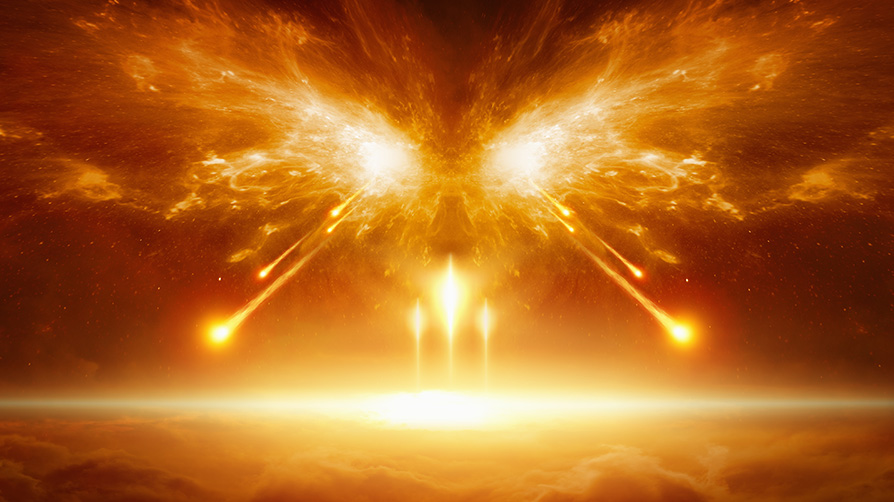

Dr. David Jeremiah Presents
Living inthe Ageof Signs
Online Destination

Living in the Age of Signs
Online Destination
The First Four Judgments and the One Worthy to Release Them
Allow me to set the stage.
The Church has just been raptured into heaven. Turmoil reigns on earth. People wander through vacant rooms, looking for loved ones. The churches that once would have offered solace stand empty. With no one left to stand up for virtue, ethical standards are replaced by vague value systems, and everyone is out for himself.
After the mass disappearance of millions, those who remain will be fearful, wondering what will happen next in this time of uncertainty. Some may cry, "God, where are You?"
The One Who Is Worthy
God is on His throne in heaven. In His right hand, He has a record of the sequence of events for the next seven years. The Father is holding a scroll with writing on both sides, containing seven seals that will reveal the sobering judgments to come upon the world before Jesus returns to earth.
Only One is worthy to take the scroll and reveal its contents, and He is the Lion of the tribe of Judah, the Root of David, the Lamb. John, his aged eyes filled with tears, watches while Jesus takes the scroll from His Father and breaks the first seal. The four living creatures and the twenty–four elders are so overcome that they fall down to worship. Then heaven echoes with a new song:
You are worthy to take the scroll and to open its seals, because you were slain, and with your blood you purchased for God persons from every tribe and language and people and nation. You have made them to be a kingdom and priests to serve our God, and they will reign on the earth.
Revelation 5:9–10, NIV
As the scroll unrolls, one seal is removed to disclose the first in a series of judgments. When successive seals are removed, the scroll unrolls again, each time revealing a worse horror. Altogether, there are three series of judgments: seven seals, seven trumpets, and seven bowls.
I believe the contents of this scroll are the same contents that were sealed up by God in Daniel 12:8–9, sealed "till the time of the end." And the only One in heaven worthy to unseal the book and read its contents becomes the focus of worship in Revelation 5. What was sealed up in Daniel's day was unsealed in John's, and the One unsealing the book is Jesus Christ Himself.
When the first seal is removed, John sees one of the infamous four horsemen of the Apocalypse.
The Counterfeit Christ on a White Horse
"I looked, and there before me was a white horse! Its rider held a bow, and he was given a crown, and he rode out as a conqueror bent on conquest" (Revelation 6:2, NIV).
Astride his prancing stallion, the Dark Prince enters the world scene with a flashing smile and an air of confidence. He chooses a white horse, the symbol of a conqueror, for his grand entrance.
At the beginning of the Tribulation, the Dark Prince enters as a victorious leader. There are two riders on white horses in Revelation: the first is this man, with a bow in his hand and a victor's crown on his head; the second is another man, with a sword for His weapon and a kingly crown upon His head. These two horsemen are diametrically different.
Donald Grey Barnhouse wrote this about them:
The counterfeit is revealed by a detailed comparison of the two riders. The One whose name is the Word of God has on His head "many crowns." The symbol is of all royalty and majesty. The Greek word is diadem. The horseman of the first seal wears no diadem. The false crown is the stephanos. Its diamonds are paste. It is the shop girl adorned with jewelry from the ten–cent counter imitating the lady born and bred who wears the rich jewels of her inheritance. All is not gold that glitters. No amount of gaudy trappings can deceive the spiritual eye. Clothes do not make the man in spite of the proverb.1
The first rider (the Antichrist) has a useless weapon, like an evil Don Quixote, but the second rider (Jesus) carries a sharp sword with which He can strike down the nations.
The great counterfeiter is none other than the Antichrist, who rides into the world at the beginning of the Tribulation period to bring peace in the midst of global turmoil. The great imitator, the cleverest mimic of all time, he will conquer without war.
The world is looking for a man on a white horse. Nations are churning. Revolutions are toppling governments. In this nuclear age, men live with the threat of international catastrophe. The final dictator, promising peace and prosperity, will be welcomed as the savior and hope of the world; he will command the military and mesmerize the masses. Governments will be united under his leadership and the people of the earth will sigh with relief, believing their future will be brighter.
The Red Horse of War and Bloodshed
"Then another horse came out, a fiery red one. Its rider was given power to take peace from the earth and to make people kill each other. To him was given a large sword" (Revelation 6:4, NIV). When Jesus removes the second seal, the angel will summon the second horse. This blood–red beast is ridden by one who carries a machaira, the assassin's sword, which can cut the throat of an animal or a man. The red horseman represents not only nation rising against nation and kingdom against kingdom, but man fighting against individual man. He ushers in a time of murder, assassination, bloodshed, and revolution.
Are wars increasing in frequency and intensity? Twice in one generation, the world was plunged into world wars. Since World War II, there have been more than three hundred wars, hundreds of political assassinations, rebellions for independence, and revolutions of either a political, economic, racial, or religious nature. As fast as we write these statistics, they are out of date.
When the second seal is opened, the message is the same as that of Jesus, "You will hear of wars and rumors of wars, but see to it that you are not alarmed. Such things must happen, but the end is still to come. . . . For then there will be great distress, unequaled from the beginning of the world until now—and never to be equaled again. If those days had not been cut short, no one would survive" (Matthew 24:6, 21–22, NIV).
How will those days be cut short? Who will survive this great holocaust? As our timetable of things to come unfolds, we'll find the answers to these gnawing questions—questions that go unspoken in the minds of concerned men and women, for fear of creating personal depression or appearing to be negative thinkers.
The Black Horse of Famine
Have you ever been hungry? I mean, really hungry, not just the need to satisfy your appetite, but the aching, clawing sensation that dominates every waking minute? I am an average American, taking the food in my cupboard for granted, seeing the waitress's cart of leftovers, tossing out half–eaten apples. In America we have forgotten the old "waste not, want not" homily. We throw enough food in our garbage cans every day to feed a family of six in India for a day. Our dogs have a diet higher in protein than most of the people of the world.
When war comes, food is often in short supply. The black horse of famine rides behind the red horse of war during the Tribulation, bringing worldwide starvation to the citizens of planet earth.
As the third seal is broken, the scroll is unrolled to reveal the next event. John tells us, "I looked, and there before me was a black horse! Its rider was holding a pair of scales in his hand. Then I heard what sounded like a voice among the four living creatures, saying, 'Two pounds of wheat for a day's wages, and six pounds of barley for a day's wages, and do not damage the oil and the wine!'" (Revelation 6:5–6, NIV)
This measure of wheat is the least amount of food one person could eat to survive. The wage–earner will take his day's salary to the central government market and be measured out his ration. But what about the children and the elderly who cannot work? How will the worker be able to sustain his family?
Starving people scavenge for food, and, with the spirit of the Lord removed, they will kill to eat. The rich and influential will have their "oil and wine," or the gourmet food from the deli. They will display their special pass—the mark "666" issued by the Antichrist—and be able to stock their shelves with choice products from the state–owned supermarket, but the poor will starve.
The Pale Horse of Death and Hades
"When the Lamb opened the fourth seal, I heard the voice of the fourth living creature say, 'Come!' I looked, and there before me was a pale horse! Its rider was named Death, and Hades was following close behind him" (Revelation 6:7–8, NIV).
John now sees two persons: Death is riding a pale horse, and Hades is following close behind him. What power they have! They will kill a fourth of the earth by sword, famine, plague, and wild beasts. Armed with these weapons, the survival rate for the remaining population will be less and less.
God's "four sore judgments" are described as "the sword, and the famine, and the noisome beast, and the pestilence" (Ezekiel 14:21, KJV). History shows that there has been a close association between these four.
As a country is engulfed in war, the able–bodied men take up arms. Farmers leave their fields, and food supplies become scarce. Soon there is malnutrition, followed by disease. Ultimately, the wild beasts prey upon the weakened people. Historians tell us that more people died of the epidemics of influenza and typhoid after World War I than died in the war itself.
The pale horse of Death and Hades is not a welcome guest during this beginning of the seven years of Tribulation. Along with this plague will be the "beasts." I don't think this means that lions and tigers will be loosed throughout the earth, but it could be a symbolic meaning for beast–like men. The word beast occurs more than thirty times in the book of Revelation, and in other places it refers to the Antichrist.
I have another theory about these beasts, since they accompany famine and plague. The most destructive creature on the earth is the rat. He is a menace to human health and food supplies, and the nasty creature comes in more than one hundred species. Rats are extremely prolific, producing five or more litters of eight to ten each year. It has been estimated that rats are responsible for the loss of more than $1 billion worth of food each year in the United States alone. Their fleas carry bubonic plague, which destroyed one–third of the population of Europe in the fourteenth century.2
The Four Horsemen Are Just the Beginning
Jesus said, "All these are the beginning of sorrows" (Matthew 24:8, KJV). This is just the preface to the Tribulation period. Before seven years have passed, the wrath of the Lord will be unleashed without restraint upon this earth.
1Donald Grey Barnhouse, Revelation: An Expository Commentary (Grand Rapids: Zondervan, 1967), 122.
2Encyclopedia Americana, Vol. 23, 264



